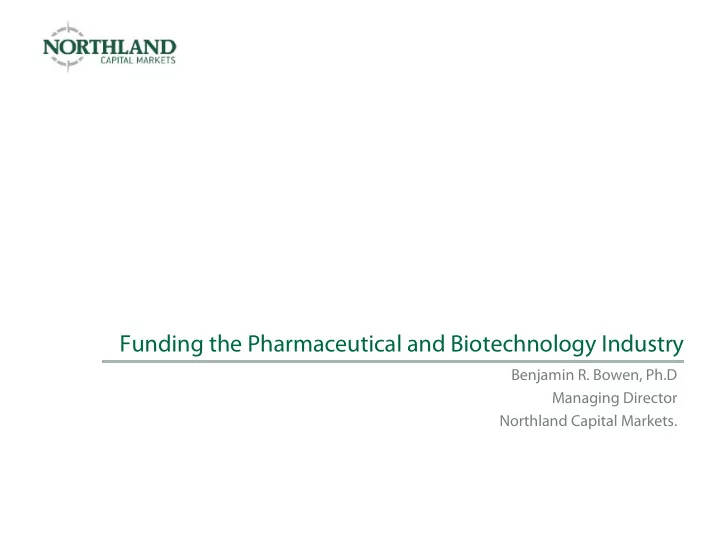

PROVIDING DIRECTION | PRODUCING RESULTS Funding the Pharmaceutical and Biotechnology Industry Benjamin R. Bowen, Ph.D Managing Director Northland Capital Markets.
How is the Creation of New Therapeutics Funded − Established companies − Some fraction of revenue typically allocated to internal R&D… − Complemented by business development strategy to identify new opportunities for licensing or acquisition… − Resulting in an actively managed, risk-adjusted pipeline − Both P&L and BS − Start-up companies − Any (and all) imaginable sources of capital − Focus of this discussion June 2016 | 2
Financing a New Biotech Company − Concept of benchmark- fi nancing − Financing to get the next “value in fl ection point” − Serial “de-risking” − Raise iterative rounds, each at higher valuation, to minimize dilution − In the ideal, investors end up with smaller slices (dilution) of a larger pie (value-creation) June 2016 | 3
Change in Value of a BioPharma Asset Source: ¡Burril ¡& ¡Co., ¡Ernst ¡& ¡Young, ¡1997 ¡ June 2016 | 4
Hypothetical Company Funding History $180.00 $160.00 Company Valuation (mm) $140.00 $120.00 $100.00 $80.00 Raised $60.00 Premoney $40.00 $20.00 $- A Round B Round IPO Formation F&F Professor @ Formation @ F&F @ A Round @ B Round @ IPO Professor Lawyer 5% 7% Professor 5% Post-doc 9% Post-doc 5% Post-doc 7% University Option 9% 11% Professor Pool IPO Professor VCs B 16% Lawyer 13% Investors 22% 30% 1% VCs A 26% F&F 42% University 15% F&F Post-doc 15% 5% 16% University University Lawyer Option 21% Post-doc 50% 1% Pool 23% Lawyer F&F VCs B 4% 4% VCs A 6% VCs A 22% University F&F 29% 21% 36% 9% Option Option Lawyer Pool Pool 2% 5% 8% June 2016 | 5
Formation of the Company − Founder(s) takes idea and forms company − Founder contributes, licenses, or otherwise acquires asset or technology to develop − Example: − Role of uncharacterized receptor and cognate peptide ligands discovered in university lab − University fi les patents on discoveries − Professor and trusted post-doc postulate that receptors and ligands have role in a disease and that the ligand could be a useful therapy − They form a company, invest $5k each to begin operations, and enter a licensing agreement with the university 5.0% Equity Ownership 22.5% Professor Post-doc University 50.0% 22.5% Lawyer June 2016 | 6
Friends and Family Stage − The company needs capital to begin operations, to pay the post-doc (now President), to rent o ffi ce & lab space, and to hire a technician − The company is valued at $1.0 million dollars and raises $250 k from: − Post-doc’s parents − Professor’s rich brother-in-law − Emeritus professor who started a company 20 years ago − Two of the lawyer’s clients who invest in local startups − Company also establishes an option pool to attract future employees June 2016 | 7
A Round Financing − Typically, fi rst institutional investor (Venture Capital, Hedge Funds, etc.) round − After deep due diligence into IP, data, market projections, etc. − Investors will likely seek representation on board of directors June 2016 | 8
B Round Financing − Institutional investors, perhaps including strategic investors (like big pharma companies) − Often institutional investors will own most of the company and thus control it − Implications for founders’ roles − Company may start to prepare for “exit” − Path to IPO or trade sale − Gives investors ability to monetize the value created since inception June 2016 | 9
Initial Public O ff ering (IPO) − Company enters public markets in conjunction with capital raise − Process: − Hire underwriters (investment banks) − Prepare and fi le public disclosure documents with the SEC − Banks sell stock to public market investors (Mutual funds, hedge funds, private individuals, etc.) through price discovery process mediated by banks − Company “goes public” and anyone can trade the stock June 2016 | 10
Public Capital Markets − Can provide means to o ff er stock on a public or private basis − Public companies generally maintain a cash “runway” − Milestone-based fi nancing for development stage companies − Positive results buoy stock price − Raising capital by selling stock is less dilutive at higher prices June 2016 | 11
Valuing a Company − IPOs are valued in a competitive process that discovers a clearing price − Publicly listed companies have a value determined by the market that adjusts with every stock trade − Private company valuation is challenging: − Some formal methodologies: o DCF—Discounted Cash Flow o Take-out value of comparable companies o Sum-of-the-parts valuation o Step-up from prior valuation − Ultimately, value is determined by what an investor or acquirer is willing to pay and the company is willing to accept June 2016 | 12
Non-dilutive Financing − Debt − Bank loans for companies with cash fl ow − Specialty lenders that lend against biomedical assets, sometimes even prior to commercialization − Convertible debt for established public company − Grants from the government, foundations, etc. − Often slow and uncertain − May only support certain R&D, excluding crucial regulatory and early commercial activities − License deals − Company can out-license commercial rights to an assets − Potential for upfront and trailing license fees, royalties − Royalties − Company can sell revenue interest in a commercial or soon-to-be commercial asset June 2016 | 13
Recommend
More recommend